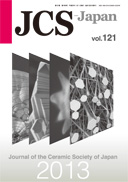Volume 117, Issue 1370
(October)
Displaying 1-18 of 18 articles from this issue
- |<
- <
- 1
- >
- >|
Special Article: The 63th CerSJ Awards for Academic Achievement in Ceramic Science and Technology: Review
-
2009 Volume 117 Issue 1370 Pages 1055-1059
Published: 2009
Released on J-STAGE: October 01, 2009
Download PDF (1344K)
Papers
-
2009 Volume 117 Issue 1370 Pages 1060-1064
Published: 2009
Released on J-STAGE: October 01, 2009
Download PDF (1478K) -
2009 Volume 117 Issue 1370 Pages 1065-1068
Published: 2009
Released on J-STAGE: October 01, 2009
Download PDF (755K) -
2009 Volume 117 Issue 1370 Pages 1069-1073
Published: 2009
Released on J-STAGE: October 01, 2009
Download PDF (1219K) -
2009 Volume 117 Issue 1370 Pages 1074-1077
Published: 2009
Released on J-STAGE: October 01, 2009
Download PDF (598K) -
2009 Volume 117 Issue 1370 Pages 1078-1084
Published: 2009
Released on J-STAGE: October 01, 2009
Download PDF (1018K) -
2009 Volume 117 Issue 1370 Pages 1085-1088
Published: 2009
Released on J-STAGE: October 01, 2009
Download PDF (772K) -
2009 Volume 117 Issue 1370 Pages 1089-1094
Published: 2009
Released on J-STAGE: October 01, 2009
Download PDF (729K) -
2009 Volume 117 Issue 1370 Pages 1095-1100
Published: 2009
Released on J-STAGE: October 01, 2009
Download PDF (644K) -
2009 Volume 117 Issue 1370 Pages 1101-1104
Published: 2009
Released on J-STAGE: October 01, 2009
Download PDF (512K) -
2009 Volume 117 Issue 1370 Pages 1105-1111
Published: 2009
Released on J-STAGE: October 01, 2009
Download PDF (839K) -
2009 Volume 117 Issue 1370 Pages 1112-1114
Published: 2009
Released on J-STAGE: October 01, 2009
Download PDF (572K) -
2009 Volume 117 Issue 1370 Pages 1115-1119
Published: 2009
Released on J-STAGE: October 01, 2009
Download PDF (513K) -
2009 Volume 117 Issue 1370 Pages 1120-1125
Published: 2009
Released on J-STAGE: October 01, 2009
Download PDF (1110K) -
2009 Volume 117 Issue 1370 Pages 1126-1130
Published: 2009
Released on J-STAGE: October 01, 2009
Download PDF (1492K)
Technical reports
-
2009 Volume 117 Issue 1370 Pages 1131-1133
Published: 2009
Released on J-STAGE: October 01, 2009
Download PDF (825K) -
2009 Volume 117 Issue 1370 Pages 1134-1137
Published: 2009
Released on J-STAGE: October 01, 2009
Download PDF (481K)
Express letter
-
2009 Volume 117 Issue 1370 Pages 1138-1140
Published: 2009
Released on J-STAGE: October 01, 2009
Download PDF (584K)
- |<
- <
- 1
- >
- >|
